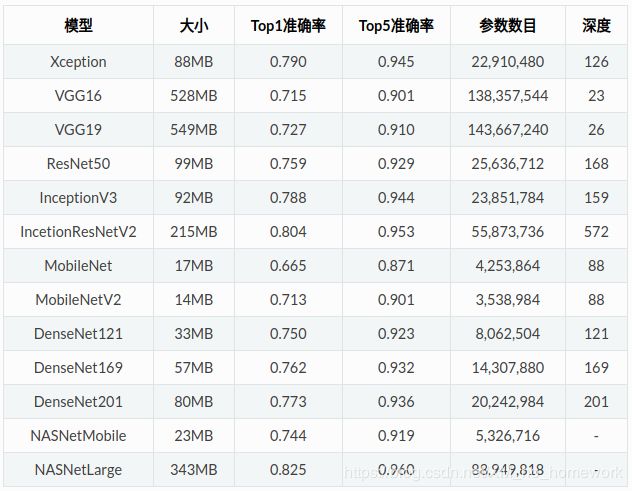Keras学习笔记(一): Application 各model参数及应用
Keras Application应用
转自:https://keras-cn.readthedocs.io/en/latest/
Kera的应用模块Application提供了带有预训练权重的Keras模型,这些模型可以用来进行预测、特征提取和finetune
模型的预训练权重将下载到~/.keras/models/并在载入模型时自动载入
可用的模型
应用于图像分类的模型,权重训练自ImageNet: Xception VGG16 VGG19 ResNet50 InceptionV3 InceptionResNetV2 MobileNet DenseNet NasNet MobileNetV2
Xception模型仅在TensorFlow下可用,因为它依赖的SeparableConvolution层仅在TensorFlow可用。MobileNet仅在TensorFlow下可用,因为它依赖的DepethwiseConvolution层仅在TF下可用。
模型信息
Xception模型
keras.applications.xception.Xception(include_top=True, weights='imagenet',
input_tensor=None, input_shape=None,
pooling=None, classes=1000)
Xception V1 模型, 权重由ImageNet训练而言
在ImageNet上,该模型取得了验证集top1 0.790和top5 0.945的正确率
注意,该模型目前仅能以TensorFlow为后端使用,由于它依赖于"SeparableConvolution"层,目前该模型只支持channels_last的维度顺序(width, height, channels)
默认输入图片大小为299x299
参数
include_top:是否保留顶层的3个全连接网络
weights:None代表随机初始化,即不加载预训练权重。'imagenet’代表加载预训练权重
input_tensor:可填入Keras tensor作为模型的图像输出tensor
input_shape:可选,仅当include_top=False有效,应为长为3的tuple,指明输入图片的shape,图片的宽高必须大于71,如(150,150,3)
pooling:当include_top=False时,该参数指定了池化方式。None代表不池化,最后一个卷积层的输出为4D张量。‘avg’代表全局平均池化,‘max’代表全局最大值池化。
classes:可选,图片分类的类别数,仅当include_top=True并且不加载预训练权重时可用。
返回值
Keras 模型对象
VGG16模型
keras.applications.vgg16.VGG16(include_top=True, weights='imagenet',
input_tensor=None, input_shape=None,
pooling=None,
classes=1000)
VGG16模型,权重由ImageNet训练而来
该模型再Theano和TensorFlow后端均可使用,并接受channels_first和channels_last两种输入维度顺序
模型的默认输入尺寸是224x224
参数:
include_top:是否保留顶层的3个全连接网络
weights:None代表随机初始化,即不加载预训练权重。'imagenet’代表加载预训练权重
input_tensor:可填入Keras tensor作为模型的图像输出tensor
input_shape:可选,仅当include_top=False有效,应为长为3的tuple,指明输入图片的shape,图片的宽高必须大于48,如(200,200,3)
pooling:当include_top=False时,该参数指定了池化方式。None代表不池化,最后一个卷积层的输出为4D张量。‘avg’代表全局平均池化,‘max’代表全局最大值池化。
classes:可选,图片分类的类别数,仅当include_top=True并且不加载预训练权重时可用。
返回值:
Keras 模型对象
VGG19模型
keras.applications.vgg19.VGG19(include_top=True, weights='imagenet',
input_tensor=None, input_shape=None,
pooling=None,
classes=1000)
VGG19模型,权重由ImageNet训练而来
该模型在Theano和TensorFlow后端均可使用,并接受channels_first和channels_last两种输入维度顺序
模型的默认输入尺寸是224x224
参数
include_top:是否保留顶层的3个全连接网络
weights:None代表随机初始化,即不加载预训练权重。'imagenet’代表加载预训练权重
input_tensor:可填入Keras tensor作为模型的图像输出tensor
input_shape:可选,仅当include_top=False有效,应为长为3的tuple,指明输入图片的shape,图片的宽高必须大于48,如(200,200,3)
pooling:当include_top=False时,该参数指定了池化方式。None代表不池化,最后一个卷积层的输出为4D张量。‘avg’代表全局平均池化,‘max’代表全局最大值池化。
classes:可选,图片分类的类别数,仅当include_top=True并且不加载预训练权重时可用。
返回值
Keras 模型对象
ResNet50模型
keras.applications.resnet50.ResNet50(include_top=True, weights='imagenet',
input_tensor=None, input_shape=None,
pooling=None,
classes=1000)
50层残差网络模型,权重训练自ImageNet
该模型在Theano和TensorFlow后端均可使用,并接受channels_first和channels_last两种输入维度顺序
模型的默认输入尺寸是224x224
参数
include_top:是否保留顶层的全连接网络
weights:None代表随机初始化,即不加载预训练权重。'imagenet’代表加载预训练权重
input_tensor:可填入Keras tensor作为模型的图像输出tensor
input_shape:可选,仅当include_top=False有效,应为长为3的tuple,指明输入图片的shape,图片的宽高必须大于197,如(200,200,3)
pooling:当include_top=False时,该参数指定了池化方式。None代表不池化,最后一个卷积层的输出为4D张量。‘avg’代表全局平均池化,‘max’代表全局最大值池化。
classes:可选,图片分类的类别数,仅当include_top=True并且不加载预训练权重时可用。
返回值
Keras 模型对象
InceptionV3模型
keras.applications.inception_v3.InceptionV3(include_top=True,
weights='imagenet',
input_tensor=None,
input_shape=None,
pooling=None,
classes=1000)
InceptionV3网络,权重训练自ImageNet
该模型在Theano和TensorFlow后端均可使用,并接受channels_first和channels_last两种输入维度顺序
模型的默认输入尺寸是299x299
参数
include_top:是否保留顶层的全连接网络
weights:None代表随机初始化,即不加载预训练权重。'imagenet’代表加载预训练权重
input_tensor:可填入Keras tensor作为模型的图像输出tensor
input_shape:可选,仅当include_top=False有效,应为长为3的tuple,指明输入图片的shape,图片的宽高必须大于197,如(200,200,3)
pooling:当include_top=False时,该参数指定了池化方式。None代表不池化,最后一个卷积层的输出为4D张量。‘avg’代表全局平均池化,‘max’代表全局最大值池化。
classes:可选,图片分类的类别数,仅当include_top=True并且不加载预训练权重时可用。
返回值
Keras 模型对象
InceptionResNetV2模型
keras.applications.inception_resnet_v2.InceptionResNetV2(include_top=True, weights=‘imagenet’, input_tensor=None, input_shape=None, pooling=None, classes=1000)
InceptionResNetV2网络,权重训练自ImageNet
该模型在Theano、TensorFlow和CNTK后端均可使用,并接受channels_first和channels_last两种输入维度顺序
模型的默认输入尺寸是299x299
参数
include_top:是否保留顶层的全连接网络
weights:None代表随机初始化,即不加载预训练权重。'imagenet’代表加载预训练权重
input_tensor:可填入Keras tensor作为模型的图像输出tensor
input_shape:可选,仅当include_top=False有效,应为长为3的tuple,指明输入图片的shape,图片的宽高必须大于197,如(200,200,3)
pooling:当include_top=False时,该参数指定了池化方式。None代表不池化,最后一个卷积层的输出为4D张量。‘avg’代表全局平均池化,‘max’代表全局最大值池化。
classes:可选,图片分类的类别数,仅当include_top=True并且不加载预训练权重时可用。
返回值
Keras 模型对象
MobileNet模型
keras.applications.mobilenet.MobileNet(input_shape=None, alpha=1.0, depth_multiplier=1, dropout=1e-3, include_top=True, weights='imagenet', input_tensor=None, pooling=None, classes=1000)
MobileNet网络,权重训练自ImageNet
该模型仅在TensorFlow后端均可使用,因此仅channels_last维度顺序可用。当需要以load_model()加载MobileNet时,需要在custom_object中传入relu6和DepthwiseConv2D,即:
model = load_model('mobilenet.h5', custom_objects={
'relu6': mobilenet.relu6,
'DepthwiseConv2D': mobilenet.DepthwiseConv2D})
模型的默认输入尺寸是224x224
参数
include_top:是否保留顶层的全连接网络
weights:None代表随机初始化,即不加载预训练权重。'imagenet’代表加载预训练权重
input_tensor:可填入Keras tensor作为模型的图像输出tensor
input_shape:可选,仅当include_top=False有效,应为长为3的tuple,指明输入图片的shape,图片的宽高必须大于197,如(200,200,3)
pooling:当include_top=False时,该参数指定了池化方式。None代表不池化,最后一个卷积层的输出为4D张量。‘avg’代表全局平均池化,‘max’代表全局最大值池化。
classes:可选,图片分类的类别数,仅当include_top=True并且不加载预训练权重时可用。
alpha: 控制网络的宽度:
如果alpha<1,则同比例的减少每层的滤波器个数
如果alpha>1,则同比例增加每层的滤波器个数
如果alpha=1,使用默认的滤波器个数
depth_multiplier:depthwise卷积的深度乘子,也称为(分辨率乘子)
dropout:dropout比例
返回值
Keras 模型对象
DenseNet模型
keras.applications.densenet.DenseNet121(include_top=True, weights='imagenet', input_tensor=None, input_shape=None, pooling=None, classes=1000)
keras.applications.densenet.DenseNet169(include_top=True, weights='imagenet', input_tensor=None, input_shape=None, pooling=None, classes=1000)
keras.applications.densenet.DenseNet201(include_top=True, weights='imagenet', input_tensor=None, input_shape=None, pooling=None, classes=1000)
DenseNet网络,权重训练自ImageNet
该模型既可以使用channels_first维度顺序(channels, height, width),也可以使用channels_last维度顺序(height, width, channels)
模型的默认输入尺寸是224x224
参数
include_top:是否保留顶层的全连接网络
weights:None代表随机初始化,即不加载预训练权重。'imagenet’代表加载预训练权重。或须载入的权重文件的路径。
input_tensor:可填入Keras tensor作为模型的图像输出tensor
input_shape:可选,仅当include_top=False有效,应为长为3的tuple,指明输入图片的shape,图片的宽高必须大于32,如(200,200,3)
pooling:当include_top=False时,该参数指定了池化方式。None代表不池化,最后一个卷积层的输出为4D张量。‘avg’代表全局平均池化,‘max’代表全局最大值池化。
classes:可选,图片分类的类别数,仅当include_top=True并且不加载预训练权重时可用。
返回值
Keras 模型对象
NasNet模型
keras.applications.nasnet.NASNetLarge(input_shape=None, include_top=True, weights=‘imagenet’, input_tensor=None, pooling=None, classes=1000)
keras.applications.nasnet.NASNetMobile(input_shape=None, include_top=True, weights=‘imagenet’, input_tensor=None, pooling=None, classes=1000)
神经结构搜索(NasNet)网络,权重训练自ImageNet
NASNetLarge模型的默认输入尺寸是331x331,NASNetMobile模型的默认输入尺寸是224x224
参数
input_shape:可选,仅当include_top=False有效,应为长为3的tuple,指明输入图片的shape,图片的宽高必须大于32,如(200,200,3)
include_top:是否保留顶层的全连接网络
weights:None代表随机初始化,即不加载预训练权重。'imagenet’代表加载预训练权重
input_tensor:可填入Keras tensor作为模型的图像输出tensor
pooling:当include_top=False时,该参数指定了池化方式。None代表不池化,最后一个卷积层的输出为4D张量。‘avg’代表全局平均池化,‘max’代表全局最大值池化。
classes:可选,图片分类的类别数,仅当include_top=True并且不加载预训练权重时可用。
返回值
Keras 模型对象
MobileNet模型
keras.applications.mobilenetv2.MobileNetV2(input_shape=None, alpha=1.0, depth_multiplier=1, include_top=True, weights='imagenet', input_tensor=None, pooling=None, classes=1000)
MobileNet网络,权重训练自ImageNet
该模型仅channels_last维度顺序(height, width, channels)可用。
模型的默认输入尺寸是224x224
参数
input_shape:可选,仅当include_top=False有效,应为长为3的tuple,指明输入图片的shape,如(200,200,3)
alpha: 控制网络的宽度:
如果alpha<1,则同比例的减少每层的滤波器个数
如果alpha>1,则同比例增加每层的滤波器个数
如果alpha=1,使用默认的滤波器个数
depth_multiplier:depthwise卷积的深度乘子,也称为(分辨率乘子)
include_top:是否保留顶层的全连接网络
weights:None代表随机初始化,即不加载预训练权重。'imagenet’代表加载预训练权重。或须载入的权重文件的路径。
input_tensor:可填入Keras tensor作为模型的图像输出tensor
pooling:当include_top=False时,该参数指定了池化方式。None代表不池化,最后一个卷积层的输出为4D张量。‘avg’代表全局平均池化,‘max’代表全局最大值池化。
classes:可选,图片分类的类别数,仅当include_top=True并且不加载预训练权重时可用。
返回值
Keras 模型对象
示例
利用ResNet50网络进行ImageNet分类
from keras.applications.resnet50 import ResNet50
from keras.preprocessing import image
from keras.applications.resnet50 import preprocess_input, decode_predictions
import numpy as np
model = ResNet50(weights='imagenet')
img_path = 'elephant.jpg'
img = image.load_img(img_path, target_size=(224, 224))
x = image.img_to_array(img)
x = np.expand_dims(x, axis=0)
x = preprocess_input(x)
preds = model.predict(x)
# decode the results into a list of tuples (class, description, probability)
# (one such list for each sample in the batch)
print('Predicted:', decode_predictions(preds, top=3)[0])
# Predicted: [(u'n02504013', u'Indian_elephant', 0.82658225), (u'n01871265', u'tusker', 0.1122357), (u'n02504458', u'African_elephant', 0.061040461)]
利用VGG16提取特征
from keras.applications.vgg16 import VGG16
from keras.preprocessing import image
from keras.applications.vgg16 import preprocess_input
import numpy as np
model = VGG16(weights='imagenet', include_top=False)
img_path = 'elephant.jpg'
img = image.load_img(img_path, target_size=(224, 224))
x = image.img_to_array(img)
x = np.expand_dims(x, axis=0)
x = preprocess_input(x)
features = model.predict(x)
从VGG19的任意中间层中抽取特征
from keras.applications.vgg19 import VGG19
from keras.preprocessing import image
from keras.applications.vgg19 import preprocess_input
from keras.models import Model
import numpy as np
base_model = VGG19(weights='imagenet')
model = Model(inputs=base_model.input, outputs=base_model.get_layer('block4_pool').output)
img_path = 'elephant.jpg'
img = image.load_img(img_path, target_size=(224, 224))
x = image.img_to_array(img)
x = np.expand_dims(x, axis=0)
x = preprocess_input(x)
block4_pool_features = model.predict(x)
在新类别上fine-tune inceptionV3
from keras.applications.inception_v3 import InceptionV3
from keras.preprocessing import image
from keras.models import Model
from keras.layers import Dense, GlobalAveragePooling2D
from keras import backend as K
# create the base pre-trained model
base_model = InceptionV3(weights='imagenet', include_top=False)
# add a global spatial average pooling layer
x = base_model.output
x = GlobalAveragePooling2D()(x)
# let's add a fully-connected layer
x = Dense(1024, activation='relu')(x)
# and a logistic layer -- let's say we have 200 classes
predictions = Dense(200, activation='softmax')(x)
# this is the model we will train
model = Model(inputs=base_model.input, outputs=predictions)
# first: train only the top layers (which were randomly initialized)
# i.e. freeze all convolutional InceptionV3 layers
for layer in base_model.layers:
layer.trainable = False
# compile the model (should be done *after* setting layers to non-trainable)
model.compile(optimizer='rmsprop', loss='categorical_crossentropy')
# train the model on the new data for a few epochs
model.fit_generator(...)
# at this point, the top layers are well trained and we can start fine-tuning
# convolutional layers from inception V3. We will freeze the bottom N layers
# and train the remaining top layers.
# let's visualize layer names and layer indices to see how many layers
# we should freeze:
for i, layer in enumerate(base_model.layers):
print(i, layer.name)
# we chose to train the top 2 inception blocks, i.e. we will freeze
# the first 249 layers and unfreeze the rest:
for layer in model.layers[:249]:
layer.trainable = False
for layer in model.layers[249:]:
layer.trainable = True
# we need to recompile the model for these modifications to take effect
# we use SGD with a low learning rate
from keras.optimizers import SGD
model.compile(optimizer=SGD(lr=0.0001, momentum=0.9), loss='categorical_crossentropy')
# we train our model again (this time fine-tuning the top 2 inception blocks
# alongside the top Dense layers
model.fit_generator(...)
在定制的输入tensor上构建InceptionV3
from keras.applications.inception_v3 import InceptionV3
from keras.layers import Input
# this could also be the output a different Keras model or layer
input_tensor = Input(shape=(224, 224, 3)) # this assumes K.image_data_format() == 'channels_last'
model = InceptionV3(input_tensor=input_tensor, weights='imagenet', include_top=True)
